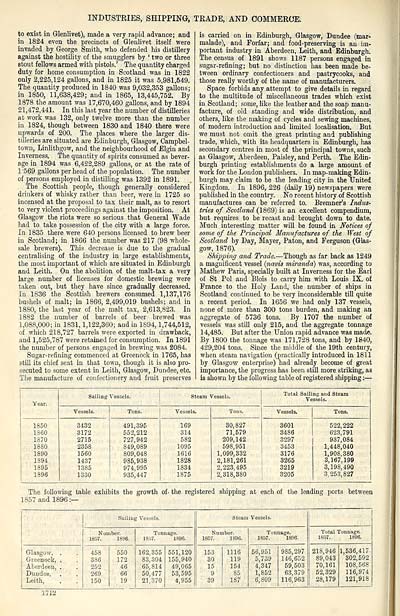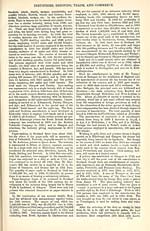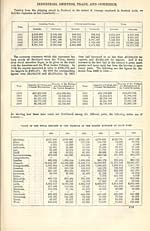Ordnance gazetteer of Scotland
(1720) Page 1712
Download files
Complete book:
Individual page:
Thumbnail gallery: Grid view | List view

INDUSTEIES, SHIPPING, TRADE, AND COMMERCE.
to exist in Glenlivet), made a very rapid advance; and
in 1824 even the precincts of Glenlivet itself were
invaded by George Smith, who defended his distillery
against the hostility of the smugglers by ' two or three
stout fellows armed with pistols.' The quantity charged
duty for home consumption in Scotland was in 1822
only 2,225,124 gallons, and in 1825 it was 5,981,549.
The quantity produced in 1840 was 9,032,353 gallons;
in 1850, 11,638,429; and in 1865, 13,445,752. By
1878 the amount was 17,670,460 gallons, and by 1894
21,472,441. In this last year the number of distilleries
at work was 132, only twelve more than the number
in 1824, though between 1830 and 1840 there were
upwards of 200. The places where the larger dis-
tilleries are situated are Edinburgh, Glasgow, Campbel-
town, Linlithgow, and the neighbourhood of Elgin and
Inverness. The quantity of spirits consumed as bever-
age in 1894 was 6,422,289 gallons, or at the rate of
1 '569 gallons per head of the population. The number
of persons employed in distilling was 1392 in 1891.
The Scottish people, though generally considered
drinkers of whisky rather than beer, were in 1725 so
incensed at the proposal to tax their malt, as to resort
to very violent proceedings against the imposition. At
Glasgow the riots were so serious that General Wade
had to take possession of the city with a large force.
In 1835 there were 640 persons licensed to brew beer
in Scotland; in 1866 the number was 217 (98 whole-
sale brewers). This decrease is due to the gradual
centralising of the industry in large establishments,
the most important of which are situated in Edinburgh
and Leith. On the abolition of the malt-tax a very
large number of licenses for domestic brewing were
taken out, but they have since gradually decreased.
In 1836 the Scottish brewers consumed 1,137,176
bushels of malt; in 1866, 2,499,019 bushels; and in
18S0, the last year of the malt tax, 2,613,823. In
1882 the number of barrels of beer brewed was
1,088,000; in 1831, 1,122,360; and in 1894, 1,744,512,
of which 218,727 barrels were exported in drawback,
and 1,525,787 were retained for consumption. In 1891
the number of persons engaged in brewing was 2084.
Sugar-refining commenced at Greenock in 1765, has
still its chief seat in that town, though it is also pro-
secuted to some extent in Leith, Glasgow, Dundee, etc.
The manufacture of confectionery and fruit preserves
is carried on in Edinburgh, Glasgow, Dundee (mar-
malade), and Forfar; and food-preserving is an im-
portant industry in Aberdeen, Leith, and Edinburgh.
The census of 1891 shows 1187 persons engaged in
sugar- refining; but no distinction has been made be-
tween ordinary confectioners and pastrycooks, and
those really worthy of the name of manufacturers.
Space forbids any attempt to give details in regard
to the multitude of miscellaneous trades which exist
in Scotland; some, like the leather and the soap manu-
facture, of old standing and wide distribution, and
others, like the making of cycles and sewing machines,
of modern introduction and limited localisation. But
we must not omit the great printing and publishing
trade, which, with its headquarters in Edinburgh, has
secondary centres in most of the principal towns, such
as Glasgow, Aberdeen, Paisley, and Perth. The Edin-
burgh printing establishments do a large amount of
work for the London publishers. In map-making Edin-
burgh may claim to be the leading city in the United
Kingdom. In 1896, 226 (daily 19) newspapers were
published in the country. No recent history of Scottish
manufactures can be referred to. Bremner's Indus-
tries of Scotland (1869) is an excellent compendium,
but requires to be recast and brought down to date.
Much interesting matter will be found in Notices of
some of the Principal Manufactures of the West of
Scotland by Day, Mayer, Paton, and Ferguson (Glas-
gow, 1876).
Shipping and Trade. — Though as far back as 1249
a magnificent vessel (navis miranda) was, according to
Mathew Paris, specially built at Inverness for the Earl
of St Pol and Blois to carry him with Louis IX. of
France to the Holy Land, the number of ships in
Scotland continued to be very inconsiderable till quite
a recent period. In 1656 we had only 137 vessels,
none of more than 300 tons burden, and making an
aggregate of 5736 tons. By 1707 the number of
vessels was still only 215, and the aggregate tonnage
14,485. But after the Union rapid advance was made.
By 1800 the tonnage was 171,728 tons, and by 1840,
429,204 tons. Since the middle of the 19th century,
when steam navigation (practically introduced in 1811
by Glasgow enterprise) had already become of great
importance, the progress has been still more striking, as
is shown by the following table of registered shipping : —
Sailing Vessels.
Steam Vessels.
Total Sailing and Steam
Year.
Vessels.
Tons.
Vessels.
Tons.
Vessels.
Tons.
1850
3432
491,395
169
30,827
3601
522,222
1860
3172
552,212
314
71,579
3486
623,791
1870
2715
727,942
582
209,142
3297
937,084
1880
2358
849,089
1095
598,951
3453
1,448,040
1890
1560
809,048
1616
1,099,332
3176
1,908,380
1894
1437
985,938
1828
2,181,261
3265
3,167,199
1895
1385
974,995
1834
2,223,495
3219
3,198,490
1896
1330
935,447
1875
2,318,380
3205
3,253,827
The folloi
ving table exhibits the growth
of- the registered shipping at
;ach of the leading ports between
1857 and IE
96:—
Sailing Vessels.
Steam Vessels.
Number.
1857. 1896.
Tonnage.
1857. 1S96.
Number.
1857. 1S96.
Tonnage.
1857. 1896.
Total Tonnage.
1857. 1896.
Glasgow, .
Greenock, .
Aberdeen, .
Dundee,
Leith,
458
386
252
269.
150
550
172
46
66
19
162,355
83,304
65,814
50,477
21,370
551,120
155,940
49,065
53,595
4,955
153
30
15
9
39
1116
119
154
85
187
56,951
5,739
4,347
1,852
6,809
985,297
146,652
59,503
63,379
116,963
218,946
89,043
70,161
52,329
28,179
1,536,417
302,592
108,568
116,974
121,918
nrz
to exist in Glenlivet), made a very rapid advance; and
in 1824 even the precincts of Glenlivet itself were
invaded by George Smith, who defended his distillery
against the hostility of the smugglers by ' two or three
stout fellows armed with pistols.' The quantity charged
duty for home consumption in Scotland was in 1822
only 2,225,124 gallons, and in 1825 it was 5,981,549.
The quantity produced in 1840 was 9,032,353 gallons;
in 1850, 11,638,429; and in 1865, 13,445,752. By
1878 the amount was 17,670,460 gallons, and by 1894
21,472,441. In this last year the number of distilleries
at work was 132, only twelve more than the number
in 1824, though between 1830 and 1840 there were
upwards of 200. The places where the larger dis-
tilleries are situated are Edinburgh, Glasgow, Campbel-
town, Linlithgow, and the neighbourhood of Elgin and
Inverness. The quantity of spirits consumed as bever-
age in 1894 was 6,422,289 gallons, or at the rate of
1 '569 gallons per head of the population. The number
of persons employed in distilling was 1392 in 1891.
The Scottish people, though generally considered
drinkers of whisky rather than beer, were in 1725 so
incensed at the proposal to tax their malt, as to resort
to very violent proceedings against the imposition. At
Glasgow the riots were so serious that General Wade
had to take possession of the city with a large force.
In 1835 there were 640 persons licensed to brew beer
in Scotland; in 1866 the number was 217 (98 whole-
sale brewers). This decrease is due to the gradual
centralising of the industry in large establishments,
the most important of which are situated in Edinburgh
and Leith. On the abolition of the malt-tax a very
large number of licenses for domestic brewing were
taken out, but they have since gradually decreased.
In 1836 the Scottish brewers consumed 1,137,176
bushels of malt; in 1866, 2,499,019 bushels; and in
18S0, the last year of the malt tax, 2,613,823. In
1882 the number of barrels of beer brewed was
1,088,000; in 1831, 1,122,360; and in 1894, 1,744,512,
of which 218,727 barrels were exported in drawback,
and 1,525,787 were retained for consumption. In 1891
the number of persons engaged in brewing was 2084.
Sugar-refining commenced at Greenock in 1765, has
still its chief seat in that town, though it is also pro-
secuted to some extent in Leith, Glasgow, Dundee, etc.
The manufacture of confectionery and fruit preserves
is carried on in Edinburgh, Glasgow, Dundee (mar-
malade), and Forfar; and food-preserving is an im-
portant industry in Aberdeen, Leith, and Edinburgh.
The census of 1891 shows 1187 persons engaged in
sugar- refining; but no distinction has been made be-
tween ordinary confectioners and pastrycooks, and
those really worthy of the name of manufacturers.
Space forbids any attempt to give details in regard
to the multitude of miscellaneous trades which exist
in Scotland; some, like the leather and the soap manu-
facture, of old standing and wide distribution, and
others, like the making of cycles and sewing machines,
of modern introduction and limited localisation. But
we must not omit the great printing and publishing
trade, which, with its headquarters in Edinburgh, has
secondary centres in most of the principal towns, such
as Glasgow, Aberdeen, Paisley, and Perth. The Edin-
burgh printing establishments do a large amount of
work for the London publishers. In map-making Edin-
burgh may claim to be the leading city in the United
Kingdom. In 1896, 226 (daily 19) newspapers were
published in the country. No recent history of Scottish
manufactures can be referred to. Bremner's Indus-
tries of Scotland (1869) is an excellent compendium,
but requires to be recast and brought down to date.
Much interesting matter will be found in Notices of
some of the Principal Manufactures of the West of
Scotland by Day, Mayer, Paton, and Ferguson (Glas-
gow, 1876).
Shipping and Trade. — Though as far back as 1249
a magnificent vessel (navis miranda) was, according to
Mathew Paris, specially built at Inverness for the Earl
of St Pol and Blois to carry him with Louis IX. of
France to the Holy Land, the number of ships in
Scotland continued to be very inconsiderable till quite
a recent period. In 1656 we had only 137 vessels,
none of more than 300 tons burden, and making an
aggregate of 5736 tons. By 1707 the number of
vessels was still only 215, and the aggregate tonnage
14,485. But after the Union rapid advance was made.
By 1800 the tonnage was 171,728 tons, and by 1840,
429,204 tons. Since the middle of the 19th century,
when steam navigation (practically introduced in 1811
by Glasgow enterprise) had already become of great
importance, the progress has been still more striking, as
is shown by the following table of registered shipping : —
Sailing Vessels.
Steam Vessels.
Total Sailing and Steam
Year.
Vessels.
Tons.
Vessels.
Tons.
Vessels.
Tons.
1850
3432
491,395
169
30,827
3601
522,222
1860
3172
552,212
314
71,579
3486
623,791
1870
2715
727,942
582
209,142
3297
937,084
1880
2358
849,089
1095
598,951
3453
1,448,040
1890
1560
809,048
1616
1,099,332
3176
1,908,380
1894
1437
985,938
1828
2,181,261
3265
3,167,199
1895
1385
974,995
1834
2,223,495
3219
3,198,490
1896
1330
935,447
1875
2,318,380
3205
3,253,827
The folloi
ving table exhibits the growth
of- the registered shipping at
;ach of the leading ports between
1857 and IE
96:—
Sailing Vessels.
Steam Vessels.
Number.
1857. 1896.
Tonnage.
1857. 1S96.
Number.
1857. 1S96.
Tonnage.
1857. 1896.
Total Tonnage.
1857. 1896.
Glasgow, .
Greenock, .
Aberdeen, .
Dundee,
Leith,
458
386
252
269.
150
550
172
46
66
19
162,355
83,304
65,814
50,477
21,370
551,120
155,940
49,065
53,595
4,955
153
30
15
9
39
1116
119
154
85
187
56,951
5,739
4,347
1,852
6,809
985,297
146,652
59,503
63,379
116,963
218,946
89,043
70,161
52,329
28,179
1,536,417
302,592
108,568
116,974
121,918
nrz
Set display mode to: Large image | Transcription
Images and transcriptions on this page, including medium image downloads, may be used under the Creative Commons Attribution 4.0 International Licence unless otherwise stated. ![]()
| Gazetteers of Scotland, 1803-1901 > Ordnance gazetteer of Scotland > (1720) Page 1712 |
|---|
| Permanent URL | https://digital.nls.uk/97413886 |
|---|

